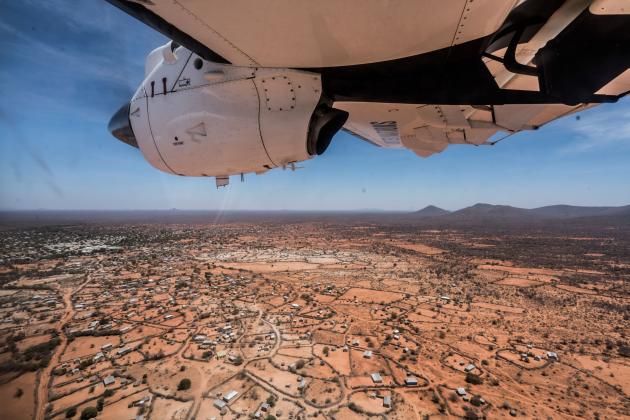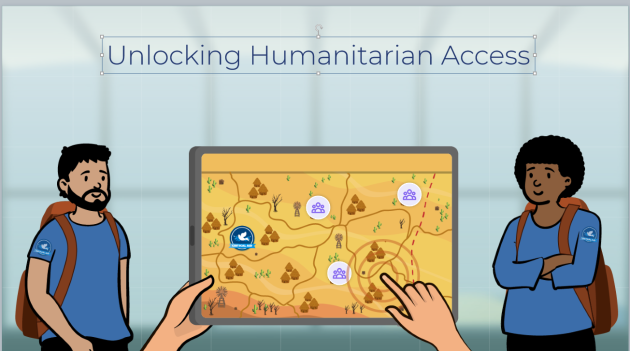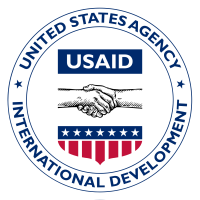Principled humanitarian access
Humanitarian access is essential for any humanitarian response. Find out more about how to define humanitarian access; what access constraints are; and the role of access coordination.

Humanitarian access is normally defined as humanitarian actors’ ability to reach affected populations as well as people’s ability to access assistance and protection. It is important to remember that humanitarian access is a dual concept as there can often be a greater focus on humanitarian actors’ ability to access populations with less attention given to peoples’ access to services.
People’s access considers the extent to which affected populations can reach humanitarian services in a safe and dignified manner. This should be considered jointly with the extent to which humanitarian actors can reach the affected populations to assess, plan, implement, deliver, and monitor aid in a principled manner.
Humanitarian access is a fundamental part of humanitarian assistance. Without some degree of access, humanitarian assistance would not be possible. Humanitarian access is essential for any humanitarian response and is guided by two founding principles: humanitarian principles and international humanitarian law. Take a look at the boxes below for more information on why these elements are relevant for humanitarian access.
Humanitarian principles provide the fundamental foundations for humanitarian action and are the central feature of humanitarians’ identity. Adherence to the principles of humanity, impartiality, neutrality, and independence is a key enabler for humanitarians to be able to establish and maintain access to people in need.
What are the humanitarian principles?
- Humanity: Human suffering must be addressed wherever it is found. This is the primary rationale and defining characteristic of humanitarian action. The principle of humanity is the overriding principle guiding humanitarian assistance.
- Impartiality: Humanitarian action must be carried out based on needs alone, with those most in need being prioritised. Assistance should be provided based on people’s needs alone regardless of who, what, and where the people we serve are.
- Neutrality: Humanitarian actors must not take sides in a conflict. Being neutral should not limit humanitarians from engaging with all actors to ensure humanitarian aid reaches the people in need, including non-state armed groups, de-facto authorities, and criminal groups.
- Independence: Humanitarian actors should be able to operate independently and not be guided by the objectives of other actors. Humanitarian action must be autonomous from political, economic, military, and other objectives that actors may hold in areas where humanitarian assistance is implemented. Decision making should be independent from political, economic, and military objectives.
It is important that all humanitarian actors and interlocutors are aware of the humanitarian principles.
Download these wallet-size Humanitarian Principles cards to remind staff what the principles are and how they guide humanitarian responses.
International humanitarian law (IHL) is the most frequently used legal framework in discussions around humanitarian access. It outlines the rights and obligations of the parties to a conflict as well as the role of humanitarian actors in situations of armed conflict.
International humanitarian law applies in two situations:
- International armed conflicts: Defined as when there is a conflict between States.
- Non-international armed conflicts: Defined as when there is at least one non-State armed actor involved in the conflict.
The classification of a conflict determines which convention of international humanitarian law applies. The Rule of Law in Armed Conflicts (RULAC) project identifies parties to a conflict and classifies situations of armed violence under international humanitarian law.
International humanitarian law provides the following legal framework for humanitarian access:
- It stipulates that each party to an armed conflict bears the primary obligation to meet the needs of the population under its control.
- Impartial humanitarian organisations have the right to offer their services to conduct humanitarian activities, if and when the parties are unable or unwilling to meet the needs of the population under their control.
- Impartial humanitarian activities undertaken in situations of armed conflict are subject to the consent of the parties to the conflict concerned. Under international humanitarian law, the parties to the conflict concerned must consent to such activities when the needs of the population under their control are not met. They must not arbitrarily withhold such consent.
- Once impartial humanitarian relief activities have been agreed to, the parties to the armed conflict as well as all States that are not a party to the armed conflict concerned must allow and facilitate rapid, unimpeded passage of the humanitarian assistance.
What are humanitarian access constraints?
Humanitarian access is rarely unhindered and there are often constraints that can impede both humanitarians’ and people’s access. These constraints are categorised and can be used as indicators to determine the levels of access to populations in need and their access to services. There are slight variations in how these constraints are described between different humanitarian actors but they often contain very similar elements. The United Nations Office for the Coordination of the Humanitarian Affairs uses the following categories to describe, understand, and monitor humanitarian access. The presence and severity of these constraints are often used to inform discussions on how humanitarian access is described. If there are several, severe constraints then access is usually described as ‘hard to reach’ or ‘inaccessible’.
What are humanitarian access negotiations?

Access coordination: The role of access working groups
Every humanitarian organisation will pursue their own strategies and approaches to secure and sustain humanitarian access. However, there can be benefits to pursuing collective efforts on humanitarian access. Coordinated approaches to access issues can strengthen humanitarians’ negotiations, decrease the likelihood of humanitarian actors taking contradictory or harmful approaches on issues, and protect individual organisations from potential retaliation by an assertive actor.
Humanitarian access working groups are now a common feature of humanitarian responses and are designed to facilitate collective engagements to address access challenges for the wider humanitarian community. The groups are usually co-chaired by the United Nations’ Office for the Coordination of Humanitarian Affairs with a non-governmental organisation or forum.
This Toolkit is designed to provide practical guidance and templates to support non-governmental organisations in their role as co-chairs of access working groups. The Toolkit has resources to support co-chairs in everything from setting up a new group, to developing joint access strategies, and effectively implementing them in a group setting.
View the Toolkit for Humanitarian Access Working Group co-chairs here
Access coordination research
Despite HAWGs' growing prominence in humanitarian responses, relatively little research and resources dedicated to humanitarian access has explicitly focused on their effectiveness and the challenges they face, including in relation to their role in supporting NSAG and DFA engagement. The EU's Directorate-General for European Civil Protection and Humanitarian Aid Operations (DG-ECHO) has recognised this gap and subsequently supported initiatives to explore the topic. The DG-ECHO funded consortium "Presence, Proximity, Protection: Building capacity to safeguard humanitarian space" has undertaken research, comprising of four country case studies, that examined the issues that facilitate or constrain a HAWG's ability to support the humanitarian community’s engagement with NSAGs and DFAs.
The findings across the case studies reveal that there is often significant commonality in the issues HAWGs grapple with despite the varied nature of the contexts studied. HAWGs play an active role in shaping the humanitarian community’s positioning and engagement with NSAGs and DFAs. Their ability to serve as an effective advisory body, however, is regularly challenged by a series of "internal" constraints including the turnover of co-chairs, the lack of clarity regarding the roles and responsibilities of the co-chairs, deficient links with key decision-making bodies and officials (HCTs and humanitarian coordinators), and a lack of clarity on how HAWGs can best add value to external engagements with NSAGs and DFAs.
For an executive summary of the findings from the case study research and the development of the toolkit, please click here.
See below, if you want to access the case study reports:
Takeover: Access coordination in Afghanistan
Cross border: Access coordination in north-west Syria
Enabling access coordination: The role of the Mali working group
Learn more on principled humanitarian access
NRC’s E-learning on humanitarian access
Improve your knowledge on humanitarian access and learn how to address access dilemmas. This interactive scenario-based e-learning is designed for humanitarian working in hard-to-reach areas. It provides humanitarians with the tools, knowledge, and skills to promote safe, sustainable, and quality humanitarian access. While it is relevant for all humanitarians wanting to learn about access, it is especially designed for colleagues in operational and management roles working in hard to reach areas.
Take the course now in:


The Norwegian Refugee Council’s humanitarian access trainings are possible thanks to funding from the United States Bureau for Humanitarian Assistance.
Sign up for NRC’s humanitarian negotiations trainings
Improve your teams’ humanitarian access negotiation skills with NRC’s four-day humanitarian negotiations training course. The course is co-facilitated with the International NGO Safety Organisation to equip frontline humanitarians with the skills to handle access and protection negotiations. In the simulations-based training, participants learn how to:
- initiate, plan, and implement humanitarian negotiation strategies,
- use communication tools and ethical influencing techniques,
- interact effectively with difficult interlocutors,
- resolve access dilemmas,
- lead or advise on negotiations.
The training is delivered in English and all participants are provided with the training materials, reference guides, and completion certificate at the end of the course.
For more information contact Theodosia Papazis - [email protected].

The Norwegian Refugee Council’s humanitarian access trainings are possible thanks to funding from the United States Bureau for Humanitarian Assistance.